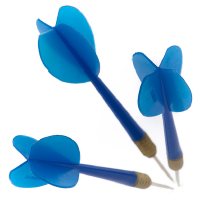This problem solving activity has a number focus.
Maddie has a dart board on which the outer ring scores 3 points and the inner ring scores 7 points.
Maddie wonders, if she uses as many darts as she likes, if she can score 58 points.
Can she get 58? If so, in how many ways?
(If she can’t score 58 points find a number in the 50s that she can get and see how many different ways she can make that number.)
- Apply number operations in combination to single digit numbers.
- Work systematically to find the possible outcomes.
This problem gives students the opportunity to be systematic in the way that they combine numbers, and to be alert to number patterns.
- Copymaster of the problem (English)
- Copymaster of the problem (Māori)
- Picture of a dartboard to introduce the problem
The Problem
Maddie has a dart board on which the outer ring scores 3 points and the inner ring scores 7 points. Maddie wonders, if she uses as many darts as she likes, if she can score 58 points.
Can she get 58? If so, in how many ways?
(If she can’t score 58 points find a number in the 50s that she can get and see how many different ways she can make that number.)
Teaching Sequence
- Display or draw the dartboard for this problem and ask the students to invent a game using the 2 rings, and 4 darts.
- Share possible games (for example, the first to a total of 20).
- Pose the problem to the class.
- Brainstorm problem solving strategies that may be useful in solving the problem.
- As the students work on the problem, ask questions that focus on systematically finding the outcomes.
How did you start the problem?
Why did you start there?
Have you found all the outcomes? How do you know?
Have you found any interesting patterns as you have been working?
Have you recorded your solution so that others would be convinced that you are correct? - If time, give students the opportunity to invent their own extra super darts problems.
- Share findings.
Extension
Is there any pattern to the number of ways that Maddie can make 58 or any other number? Check it out with other numbers.
Change the number of points that can be scored in each ring.
Solution
Maddie must make 58 using just threes and sevens. 58 divided by 7 is 8 and 2 remaining. Because 2 cannot be divided by three, she has to use fewer than 8 sevens.
Seven sevens are 49 which leaves 9 over. 9 = 3x3.
So 58 = 7x7 + 3x3. She can make 58.
This table shows a systematic approach to finding all possible ways of making 58 using threes and sevens.
| Number of sevens | 8 | 7 | 6 | 5 | 4 | 3 | 2 | 1 | 0 |
| Number of threes | 3 | 10 | 17 | ||||||
| x | 58 | x | x | 58 | x | x | 58 | x |
From the table we can see that there are 3 ways to make 58. These all involve the number of sevens decreasing by 3 while the number of threes increases by 7. Is this a coincidence?
Solution to the Extension
The pattern given in the solution always works. What is happening is that 3 lots of sevens are being replaced by 7 lots if threes. These are the only possibilities because 1 lot of sevens is not divisible by three and neither is 2 lots of sevens.
